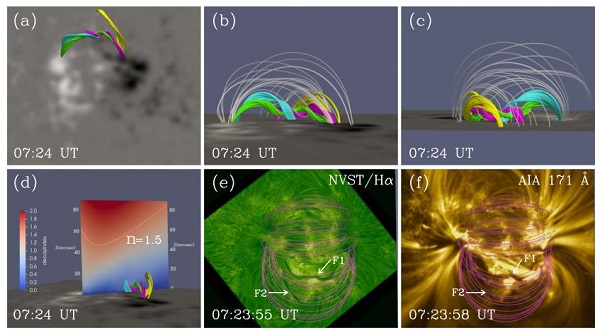Using the high spatial and temporal resolution multiwavelength observational data from the 1-m New Vacuum Solar Telescope (NVST) and the Solar Dynamic Observatory (SDO), Dr. YANG Liping, Professor YAN Xiaoli and their collaborators from the Fuxian Lake Solar Observatory have studied the interaction process between two nearby solar filaments and the successive partial filament eruptions. The relevant research results were published in the international astronomical journal The Astrophysical Journal.
Solar sympathetic filament eruptions usually involve two or more filament eruptions that occur simultaneously or successively within a relatively short time interval with a certain causal linkage. The eruption of one filament may have an effect on another one, thus resulting in the eruption of the other filament simultaneously or successively.
The researchers have performed a detailed investigation of the two nearby filaments in the active region (AR) NOAA 12866 on 2021 September 9. They found that the right part of the larger filament became active first and erupted after appearance of the brightening and bidirectional flows between the larger filament and a near smaller filament. During its eruption process, it continuously approached the smaller filament. Then they collided with each other, and the interaction happened between them. In the following, the brightening and bidirectional flows appeared between them.
This implies that magnetic reconnection occurred between the threads of two filaments. The interaction resulted in a rightward motion of the smaller filament at first, and then its activation, and finally a part of it erupted. When the erupted smaller filament deflected rapidly toward the middle part of the larger filament, the left part of the larger filament erupted with its overlying magnetic fields disturbed by the smaller filament.
Furthermore, the researchers also found that the two filaments have opposite signs of helicity, and when they collided with each other at a smaller contact angle of less than 45°, the magnetic reconnection between them would happen. This is similar to the bounce interaction picture of Linton et al. (2001).
According to the observations, the researchers concluded that these successive eruptions occurred in a relatively short time with a certain causal linkage, and their eruptions were caused by filament interaction, which can be called sympathetic eruptions. The interaction between two filaments plays an important role in triggering sympathetic filament eruptions. The results of the nonlinear force-free field (NLFFF) extrapolations reveal that the larger filament is composed of three parts of magnetic flux ropes with different twists. That is why the larger filament erupted two times. The twist of the filaments deduced from their rotational motions during their eruption processes is consistent with the NLFFF extrapolations.
This study advances the understanding of solar sympathetic eruptions and provides a good reference and idea for studying the continuous explosions of stars or other celestial bodies.
This work is sponsored by the National Science Foundation of China (NSFC), by the Yunnan Science Foundation for Distinguished Young Scholars and the Yunnan Key Laboratory of Solar Physics and Space Science, and so on.
Contact:
YAN Xiaoli
Yunnan Observatories, CAS
Email: yanxl@ynao.ac.cn

Panels (a)-(d) show the magnetic structures of the two filaments ((F1) and (F2)) and their overlying magnetic fields before their eruptions obtained by using the NLFFF extrapolation method. Panels (e)-(f) show the magnetic fields above the two filaments before their eruptions obtained by using the potential field source surface (PFSS) extrapolation model superimposed on the H-alpha image and 171Å image.